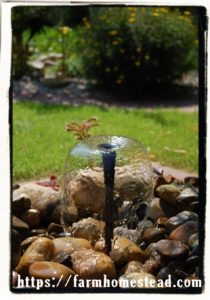Like any outdoor water source, a water garden collects organic matter that needs to be cleaned out. The best time to do this is when the water temperature is cooler, such as in the fall. This helps minimize any stress to fish that may live in your water garden. A few basic steps to cleaning your water garden and preparing it for winter include:
- Get a holding container for the plants or fish, being sure it is large enough to hold the amount of water needed to sustain the plants and fish for several hours while you are emptying and cleaning the water garden. It is best to keep the holding container in the shade during this time, also.
- Fill the holding container with water from the water garden, then empty the remainder of the water out of the garden using a pump if necessary. Use this water to irrigate other garden plants since it is rich in nutrients from the organic matter.
- As the water is being emptied out of the garden, use a stiff, nylon-bristled brush to scrub down the sides of the pond so any debris collects in the bottom of the pond.
- Use the nylon brush and a dustpan to collect up the debris and any remaining water in the bottom of the pond, placing it in a large bucket to be hauled to other garden areas and used as a soil amendment. Do not be too thorough in cleaning out your water garden – there are normal bacteria levels that need to be maintained in a water garden.
- Refill the water garden with half of the water from the holding container, then fill it the rest of the way with tap water, putting in the appropriate amount of de-chlorinator if you have fish. Next, fill the holding container with tap water also as this will help the fish become adjusted to the new water temperature.
- After a half hour or so, replace the plants and fish into the clean water garden.
Normally, you should need to clean out a water garden only once a year. Also, it should not be necessary to add fresh water unless you have a problem with your fish. Adding fresh water will not help control algae, and it may destroy the bacterial balance in your water garden.
According to Keith at Springdale Water Gardens, when getting your water garden ready for winter, there are really only a few adjustments you need to make:
- Be sure leaves are kept out as they fall to keep the debris from accumulating on the bottom of the pond.
- Set shallow plants down deep, if at all possible. It is best to leave any water lilies at the bottom all the time.
- When the weather becomes very cold, such as in late November, stop feeding the plants and fish and make no bacterial applications.
- When the pond is frozen, keep all leaves and other debris off the surface.
- You can leave your recycling pump running all winter to keep the water moving in the pond. Just be sure water does not splash out and freeze, causing more water to be diverted from flowing back into the pond. If you want to stop a waterfall type of display, disconnect the pipes and drain them, but let the pump tube bubble toward the top of the pond to keep water moving. This sometimes prevents the pond from freezing. If you decide to cut off the pump, drain it and take it inside for the winter.










